
The western pygmy blue is one of the smallest butterflies in the world and the smallest in North America. It has reached Hawaii, as well as the Persian Gulf, including eastern Saudi Arabia, Bahrain and the United Arab Emirates.
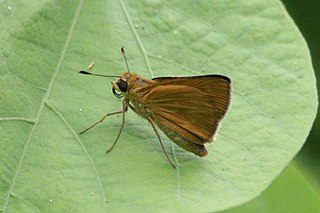
Nastra julia, the Julia's skipper, is a species of butterfly in the family Hesperiidae. It is found in North America from southern Texas to central Mexico.

Anthanassa frisia, the Cuban crescentspot, Cuban checkerspot or Cuban crescent, is a butterfly of the family Nymphalidae. Subspecies tulcis is known by the common names pale-banded crescent or Tulcis crescent; it is treated as a species by some authors. The nominate subspecies is found in the West Indies and southern Florida, with strays to northern Florida. Subspecies tulcis is found from Argentina north through Central America and Mexico to southern Texas, strays to west Texas and southern Arizona. Other subspecies are resident to South America.

Calpodes ethlius, the Brazilian skipper, larger canna leafroller or canna skipper, is a butterfly of the family Hesperiidae. It is found in the United States from southern Florida and southern Texas, south through the West Indies, Mexico, and Central America to Argentina. Strays and temporary colonies can be found north to southern Nevada, northern Texas, Illinois and Massachusetts.

Wallengrenia otho, the southern broken dash or broken dash skipper, is a butterfly of the family Hesperiidae. It was originally described by Smith in 1797. It is found from eastern Texas and the southeastern United States, south through the West Indies and Central America to Argentina. Strays can be found as far north as central Missouri, northern Kentucky and Delaware.
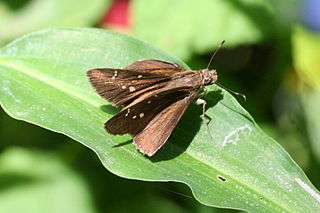
Decinea percosius, the double-dotted skipper, is a species of butterfly of the family Hesperiidae. It is found from Belize north to Mexico. It is an occasional colonist up to the lower Rio Grande Valley in Texas, US.

Texola elada, the Elada checkerspot, is a species of butterfly in the brush-footed butterfly family, Nymphalidae. It is found from southern Mexico north to central Texas and central Arizona in the United States.

Phocides polybius, the bloody spot or guava skipper, is a species of butterfly in the skipper family, Hesperiidae, that is native to the Americas. It is found from the lower Rio Grande Valley of southern Texas in the United States south through Mexico and Central America to Argentina. The species was first described by Johan Christian Fabricius in 1793.

Cecropterus dorantes, the lilac-banded longtail or Dorantes longtail, is a species of butterfly in the family Hesperiidae. It is found from Argentina, north through Central America, Mexico, and the West Indies to southern Texas and peninsular Florida. Strays can be found as far north as northern California, southern Arizona, southern Missouri and North Carolina.
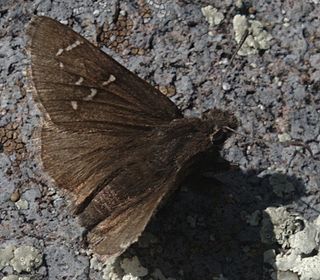
Thorybes mexicana, the Mexican cloudywing, mountain cloudy wing or Nevada cloudy wing, is a butterfly of the family Hesperiidae. It is found in the high elevation mountains of the western United States south into Mexico.

Pellicia arina, the glazed pellicia, is a butterfly of the family Hesperiidae. It is found from Panama north through Central America to northern Mexico. Rare strays are found up to the lower Rio Grande Valley in Texas.
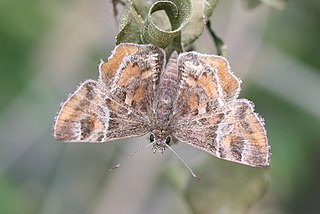
Systasea pulverulenta, the Texas powdered skipper, is a butterfly of the family Hesperiidae. It is found in North America from southern and western Texas, south through Mexico to Guatemala in Central America.

Timochares ruptifasciatus, the brown-banded skipper, is a butterfly of the family Hesperiidae. It is found in southern Texas, Mexico and Jamaica.

Chiothion asychis, the white-patched skipper or white patch, is a species of butterfly in the family Hesperiidae. It is found from Argentina, north through tropical America to the West Indies and southern Texas. Strays can be found as far north as southern Arizona, Nevada and Kansas.
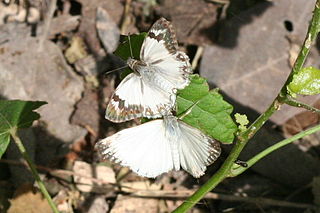
Heliopetes macaira, the Turk's-cap white-skipper , is a butterfly of the family Hesperiidae. It is found from southern Texas in North America, south through Central America to Paraguay.

Celotes nessus, the common streaky-skipper, is a butterfly of the family Hesperiidae. It is found in North America from southern Arizona, southern New Mexico, and western Texas south to northern Mexico. Rare strays can be found up to southern Oklahoma and northern Louisiana.
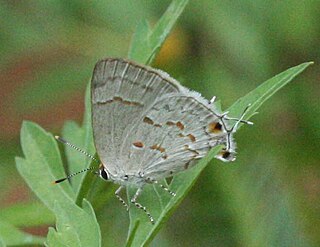
Tmolus echion, the red-spotted hairstreak or larger lantana butterfly, is a butterfly in the family Lycaenidae. It is found from Brazil, north to Sinaloa and Tamaulipas in Mexico. Rare strays can be found in southern Texas. It was introduced to Hawaii in 1902 to control lantana.

Rekoa marius, the Marius hairstreak, is a butterfly in the family Lycaenidae. It is found from Paraguay north to Sonora in Mexico. Strays may be found as far north as southern Texas. The species used to be considered rare in the southern Texas. It is the species of Rekoa found in Arizona. The habitat consists of disturbed tropical areas.

Anthanassa texana, the Texan crescentspot, is a species of butterfly in the family Nymphalidae. It is found from Guatemala north through Mexico to southern California, east across the southern United States to northern Florida, Georgia and South Carolina. Strays may be found up to Arkansas, Missouri, Illinois, South Dakota, and central Nevada. The habitat consists of deserts, dry gulches, open areas, streamsides, road edges, and city parks.

Hamadryas glauconome, the pale cracker or glaucous cracker, is a species of cracker butterfly in the family Nymphalidae. It was described by Henry Walter Bates in 1864 and is found in Mexico, Central America and south to Peru. It has been recorded as an unexpected vagrant in the United States in southern Florida, Arizona and Texas.





















